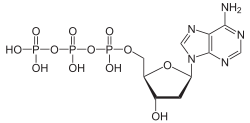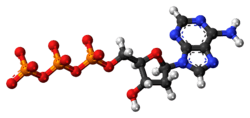Deoxyadenosine triphosphate
Deoxyadenosine triphosphate (dATP) is a nucleotide used in cells for DNA synthesis (or replication), as a substrate of DNA polymerase.[1] It is classified as a purine nucleoside triphosphate, with its chemical structure consisting of a deoxyribose sugar molecule bound to an adenine and to three phosphate groups. It differs from the energy-transferring molecule adenosine triphosphate (ATP) by a single hydroxyl group (the -OH group on the 2' carbon of the pentose sugar is replaced by -H in dATP), resulting in a deoxyribose instead of a ribose. Two phosphate groups can be hydrolyzed to yield deoxyadenosine monophosphate, which can then be used to synthesize DNA.[2]
 | |
 | |
| Names | |
|---|---|
| IUPAC name
[[(2R,3S,5R)-5-(6-aminopurin-9-yl)-3-hydroxyoxolan-2-yl]methoxy-hydroxyphosphoryl] phosphono hydrogen phosphate | |
| Other names
dATP, 2'-deoxyadenosine triphosphate | |
| Identifiers | |
3D model (JSmol) |
|
| ChEBI | |
| ChEMBL | |
| ChemSpider |
|
| ECHA InfoCard | 100.016.058 |
PubChem CID |
|
| UNII | |
CompTox Dashboard (EPA) |
|
| |
| |
| Properties | |
| C10H16N5O12P3 | |
| Molar mass | 491.181623 |
Except where otherwise noted, data are given for materials in their standard state (at 25 °C [77 °F], 100 kPa). | |
| Infobox references | |
Findings have also suggested that dATP can act as an energy-transferring molecule to maintain cell viability.[3]
Synthesis
Enzymatic synthesis of deoxyadenosine triphosphate
Deoxyadenosine triphosphate is able to be enzymatically synthesized with DNA as the starting material using deoxyribonuclease (DNase), nuclease P1, adenylate kinase, and pyruvate kinase.[4] The synthesis starts with the heat denaturation of DNA followed by treatment with DNase I to produce oligomers. Next, the solution is treated with nuclease P1 to form deoxynucleoside monophosphates. Using a mixture of adenylate kinase and pyruvate kinase, the deoxyadenosine monophosphate was selectively converted to dATP. After purification, a purity of 90%-95% can be achieved using this method of synthesis with a 40% overall yield.[4]
Health effects
In immunocompromised individuals
High levels of dATP in the body can be toxic and result in impaired immune function, since dATP acts as a noncompetitive inhibitor for the DNA synthesis enzyme ribonucleotide reductase. Patients with adenosine deaminase deficiency (ADA) tend to have elevated intracellular dATP concentrations because adenosine deaminase normally curbs adenosine levels by converting it into inosine.[5][6]
Deficiency of the enzyme adenosine deaminase is known to cause immunodeficiency in individuals.[7] Research has found that dATP may be a potential toxic metabolite in adenosine deaminase deficiency.[6] Patients in the study who were immunodeficient and adenosine deaminase deficient were found to have over 50 times the levels of dATP in their erythrocytes compared to non-immunodeficient, adenosine deaminase deficient patients. This is abnormal and provides evidence that increased erythrocyte dATP levels are the toxic metabolites responsible for immune system deficiency in individuals with adenosine deaminase deficiency.[6] Infusion of normal, non-enzyme deficient erythrocytes resulted in the loss of dATP in the erythrocytes of these individuals.
Cells lacking the ability to transport or phosphorylate dATP have been shown to exhibit increased resistance to the toxic effects of excessive dATP, suggesting that the toxicity of dATP is dependent on the ability to intracellularly phosphorylate dATP.[8] As such, some treatments for ADA focus on reducing dATP phosphorylation by the targeted inhibition of the responsible deoxynucleoside kinases, such as adenosine kinase and deoxycytidine kinase.[9] Deoxycytidine administered intravenously has also been used as an ADA treatment, although a clinical study found that deoxycytidine had only limited clinical effects on the T-cell immunity of ADA patients without discounting that some patients may respond more significantly to deoxycytidine therapy.[10]
In cardiac muscle
In cardiac myosin, dATP has been shown to be a viable alternative to ATP as an energy substrate for facilitating cross-bridge formation. In an experiment involving canine dilated cardiomyopathy (DCM), increasing cardiac dATP was found to be a potentially effective treatment for DCM.[11][12]
See also
- Adenosine triphosphate (ATP)
- Adenosine deaminase deficiency (ADA)
- Dilated cardiomyopathy (DCM)
References
- Romaniuk PJ, Eckstein F (July 1982). "A study of the mechanism of T4 DNA polymerase with diastereomeric phosphorothioate analogues of deoxyadenosine triphosphate". The Journal of Biological Chemistry. 257 (13): 7684–8. PMID 7045112.
- PubChem. "2'-Deoxyadenosine 5'-triphosphate". pubchem.ncbi.nlm.nih.gov. Retrieved 2020-04-30.
- Nakashima K, Nakashima H, Shimoyama M (September 1991). "Deoxyadenosine triphosphate acting as an energy-transferring molecule in adenosine deaminase inhibited human erythrocytes". Biochimica et Biophysica Acta (BBA) - Molecular Cell Research. 1094 (3): 257–62. doi:10.1016/0167-4889(91)90084-b. PMID 1911876.
- Ladner WE, Whitesides GM (1985-04-01). "Enzymic synthesis of deoxyATP using DNA as starting material". The Journal of Organic Chemistry. 50 (7): 1076–1079. doi:10.1021/jo00207a032.
- Chang CH, Cheng YC (October 1980). "Effects of deoxyadenosine triphosphate and 9-beta-D-arabinofuranosyl-adenine 5'-triphosphate on human ribonucleotide reductase from Molt-4F cells and the concept of "self-potentiation"". Cancer Research. 40 (10): 3555–8. PMID 6159965.
- Cohen A, Hirschhorn R, Horowitz SD, Rubinstein A, Polmar SH, Hong R, Martin DW (January 1978). "Deoxyadenosine triphosphate as a potentially toxic metabolite in adenosine deaminase deficiency". Proceedings of the National Academy of Sciences of the United States of America. 75 (1): 472–6. Bibcode:1978PNAS...75..472C. doi:10.1073/pnas.75.1.472. PMC 411272. PMID 272665.
- Sanchez JJ, Monaghan G, Børsting C, Norbury G, Morling N, Gaspar HB (May 2007). "Carrier frequency of a nonsense mutation in the adenosine deaminase (ADA) gene implies a high incidence of ADA-deficient severe combined immunodeficiency (SCID) in Somalia and a single, common haplotype indicates common ancestry". Annals of Human Genetics. 71 (Pt 3): 336–47. doi:10.1111/j.1469-1809.2006.00338.x. PMID 17181544.
- Ullman B, Gudas LJ, Cohen A, Martin DW (June 1978). "Deoxyadenosine metabolism and cytotoxicity in cultured mouse T lymphoma cells: a model for immunodeficiency disease". Cell. 14 (2): 365–75. doi:10.1016/0092-8674(78)90122-8. PMID 208780.
- Joachims ML, Marble PA, Laurent AB, Pastuszko P, Paliotta M, Blackburn MR, Thompson LF (December 2008). "Restoration of adenosine deaminase-deficient human thymocyte development in vitro by inhibition of deoxynucleoside kinases". Journal of Immunology. 181 (11): 8153–61. doi:10.4049/jimmunol.181.11.8153. PMC 2673198. PMID 19018008.
- Cowan MJ, Wara DW, Ammann AJ (October 1985). "Deoxycytidine therapy in two patients with adenosine deaminase deficiency and severe immunodeficiency disease". Clinical Immunology and Immunopathology. 37 (1): 30–6. doi:10.1016/0090-1229(85)90132-1. PMID 3161676.
- Cheng Y, Hogarth KA, O'Sullivan ML, Regnier M, Pyle WG (January 2016). "2-Deoxyadenosine triphosphate restores the contractile function of cardiac myofibril from adult dogs with naturally occurring dilated cardiomyopathy". American Journal of Physiology. Heart and Circulatory Physiology. 310 (1): H80-91. doi:10.1152/ajpheart.00530.2015. PMC 4796460. PMID 26497964.
- Powers JD, Yuan CC, McCabe KJ, Murray JD, Childers MC, Flint GV, et al. (June 2019). "Cardiac myosin activation with 2-deoxy-ATP via increased electrostatic interactions with actin". Proceedings of the National Academy of Sciences of the United States of America. 116 (23): 11502–11507. doi:10.1073/pnas.1905028116. PMC 6561254. PMID 31110001.